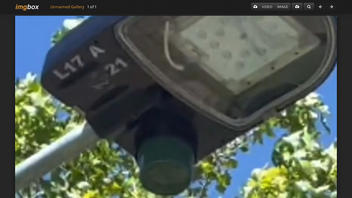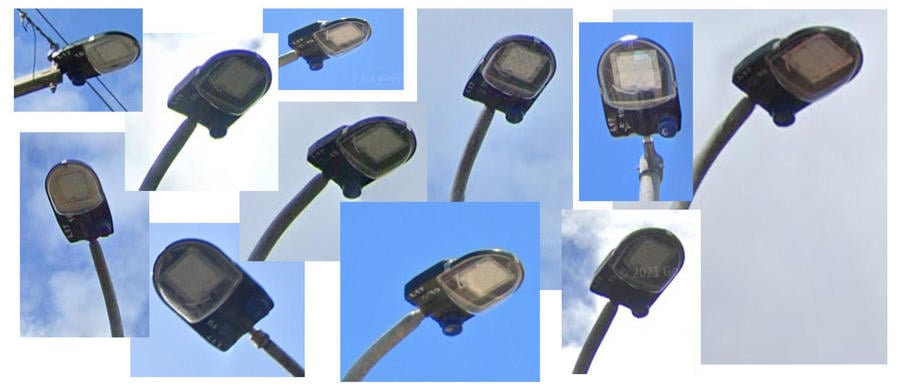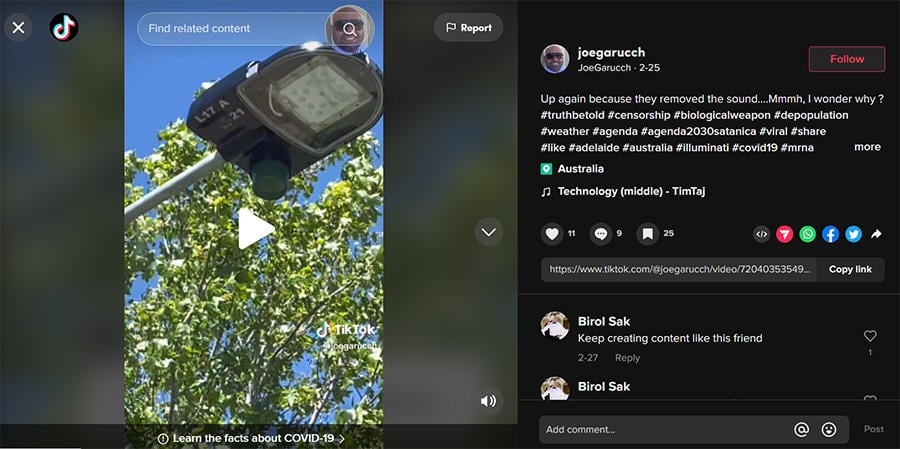STORY UPDATED: check for updates below.

Does a number code printed on a streetlight match that of a ribosomal protein and does this show that mRNA from the COVID-19 vaccines can be activated using optogenetic technology if a vaccinated person is exposed to the light from the street lamp? No, that's not true: The L17 marking on the LED street lamp appears to be a product code. The ribosomal protein RPL17A is a baker's yeast. It happens to have three matching digits with the streetlight but there is no evidence of a connection. Optogenetic technology uses light from an optical fiber to target specific cells inside the body -- which is not accomplished with a streetlight.
This video has been online since at least May 30, 2022, when it was posted on YouTube with the title, "L17-A ......LED STREET LIGHTS .........CONTROL GENES WITH LIGHT." The video was published, apparently for a second time, on TikTok by @JoeGarucch on February 25, 2023, (archived here) with following description:
Up again because they removed the sound....Mmmh, I wonder why ? #truthbetold #censorship #biologicalweapon #depopulation #weather #agenda #agenda2030satanica #viral #share #like #adelaide #australia #illuminati #covid19 #mrna #vaccine #exposed #conspiracy #dna #gene #kill #research #proof #evidence #love #tiktok #tiktokviral #repost #follow #geoengineering #storm #fakegovernment #corruption #treason #tyranny #repost
This is what the post looked like on TikTok at the time of writing:
(Source: TikTok screenshot taken on Wed May 24 18:38:58 2023 UTC)
The video begins with the narrator saying that people are asking, "Have you seen the cameras on the streetlights?" He says he does not think they are cameras. The video zooms closer to view the underside of the LED street lamp with a green plastic cylinder protruding from the bottom. This is a downward-facing photoelectric (PE) cell. This contains a sensor that will turn streetlights off at dawn and turn them on again when it gets dark.
Several models of the StreetLED MKII are pictured on the Sylvania Schréder website. A schematic diagram of the unit with the downward-facing PE cell can be seen in a PDF product information sheet. The electrical characteristics for this light list the system watts as "17W-33W." On page 3 of the .pdf are the product order codes, two for the 17 watt units, which end with the digits, "xL17," and two for the 33 watt units, which end with the digits "xL33." It appears that L17 is not a secret code connected to the illuminati, COVID, mRNA, vaccine or a conspiracy as the video's hashtags suggest. It is simply the wattage of a streetlight.
At 30 seconds into the video, a screen capture of a phone screen Google search is shown. The search entered is a very deliberate, L17-A: The hyphen is entered, erased and entered again, with no spaces. This is very specific, considering the streetlight does not have a hyphen between the 17 and the A. Elsewhere in the video (at 22 and 25 seconds) streetlights are shown that do not have a hyphen or an A.
Here is how Lead Stories found these streetlights: In the opening seconds of the video, text appears in the upper lefthand corner of the screen reading "West Lakes SA." Lead Stories used Google's Street View to look at the streetlights in West Lakes in the Australian state of South Australia, and found that this model is always marked with L17, typically with other numbers and without an A. Lead Stories reached out to Sylvania Schréder and the city of Charles Sturt, which is responsible for public lighting in West Lakes, for any additional information about what the numbering represents and will update this article if we receive a reply.
The composite image below (will open larger in a new tab) shows a random assortment of Google Street View screenshots of StreetLED MKII models found in West Lakes. 
(Image source: Lead Stories composite image with Google Street View screenshots taken on Wed May 24 22:45:47 2023 UTC)
Lead Stories reached out to SA Power Networks to ask about the numbering on the lights and received a reply from Paul Roberts, the head of Corporate Affairs, on May 25, 2023. He explained:
The numbers on the lights are asset identification markers that allow infrastructure businesses like ours to accurately identify the assets and manage their maintenance.
All our poles and other major assets are numbered so they can be accurately identified by crews when on site.
In the TikTok video, after the search for L17-A, the result chosen is a page on uniprot.org. The website's description is: "The Universal Protein Resource (UniProt) is a comprehensive resource for protein sequence and annotation data." It is managed by the UniProt consortium. The screen capture shows the UniProt.org taxonomy page of the baker's yeast called "P05740 · RL17A_YEAST." The video pauses to show text describing the protein's function, and then in red, a portion of that text is underlined (as below):
Component of the ribosome, a large ribonucleoprotein complex responsible for the synthesis of proteins in the cell. The small ribosomal subunit (SSU) binds messenger RNAs (mRNAs) and translates the encoded message by selecting cognate aminoacyl-transfer RNA (tRNA) molecules. The large subunit (LSU) contains the ribosomal catalytic site termed the peptidyl transferase center (PTC), which catalyzes the formation of peptide bonds, thereby polymerizing the amino acids delivered by tRNAs into a polypeptide chain.
In the context of this conspiracy video, it can be assumed that the above mRNA information about the baker's yeast protein is underlined because the Pfizer-BioNTech and Moderna COVID vaccines used mRNA. The COVID vaccines did not introduce mRNA into the world. It has been around as long as there have been cells -- it is found in all living cells. Just because baker's yeast protein has mRNA does not mean that it is associated with a COVID vaccine.
One minute into the video a new Google search for "lights to effect dna mrna" turns up a July, 22, 2013, MIT News article. It is titled, "Controlling genes with light: New technique can rapidly turn genes on and off, helping scientists better understand their function." The video zooms in to this paragraph and it is underlined in red:
That is now possible, thanks to a new technology developed at MIT and the Broad Institute that can rapidly start or halt the expression of any gene of interest simply by shining light on the cells.
Lead Stories emailed the Broad Institute of MIT and Harvard to ask about the lights used for optogenetic research and received a reply on May 24, 2023. David Cameron, director of external communications, offered a link to a study published in the journal Biomedical Optics Express on November 1, 2016, titled, "Characterization of fiber-optic light delivery and light-induced temperature changes in a rodent brain for precise optogenetic neuromodulation." Cameron highlighted a specific paragraph:
During in vivo optogenetic experiments, light is typically delivered into the brain via an optical fiber inserted with stereotactic guidance, and intensity measured in mW/mm2 is the recommended notation for reporting light requirement because of its inherent simplicity in measuring total light power.
So the light used in optogenetic research is a fiber-optic inserted to a precise location in the body. It is not a streetlight.
Updates:
-
2023-05-25T16:44:10Z 2023-05-25T16:44:10Z Adds response and details from SA Power Networks.















